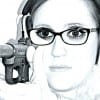As a woman, how does one find the right handgun for concealed carry?
There are many things to consider when you are choosing a handgun for concealed carry such as size, weight, caliber, recoil, holster, revolver, semi-automatic, etc. It is my opinion that your carry gun should also to be a pleasure to shoot, so that you will be more likely to practice with it. In order to find the right handgun for concealed carry you will need to assess your lifestyle to determine your needs. Ask yourself the following questions.
Where do you plan to conceal your carry gun? If you plan to conceal in a pocket or purse you may want to lean in the direction of a revolver as revolvers can be fired repeatedly while within such an enclosure. Whereas the action of a semi-automatic handgun would likely be unable to cycle and eject the first round and chamber another from within such an enclosure. If you choose to carry a revolver, I recommend a hammerless revolver, as it cannot accidentally be cocked while inside your pocket or purse and hammers have a tendency to wear holes in your clothing. If you plan to conceal on your body, decide where. There are holsters available for all kinds of carrying configurations including around the ankle, above the hip, over the kidney, and from the shoulder.
How large or small do you want your carry gun to be? Consider your wardrobe and stature to decide what you will actually be able to conceal. Are your clothes tight or loose fitting? Does a 1911 make you look like you represent the Lollipop Guild? Must you operate a Ruger LCP with tweezers and a magnifying glass? These are important items to consider.
Your ability to conceal a firearm also depends upon your holster. Shop around for concealed carry holsters because not all holsters are created equal. A holster designed for concealed carry will be slim, it will pull the firearm in close to your body so as not to bulge, and will be smooth so it does not to snag your clothes or add unnecessary contour to your outfit. If you do not plan to carry on your person, there are many purses and bags available with built-in holsters and compartments. There are also many options for magazine pouches and other carriers for reloads, which brings us to the next question.
How many rounds of ammunition do you want to carry? A revolver will typically hold 5 to 8 rounds whereas a semi-automatic handgun will hold from 7 to 17 rounds without an extended magazine. A derringer will typically only hold 1 to 5 rounds. Consider how many rounds you might realistically need. Do you want to carry reloads? If so, consider how many. Remember that more ammo equals more weight.
How heavy or light do you need your carry gun to be? Maybe you can conceal something as large as a full size 1911 but it is too heavy and gives you muscle spasms. If you are concerned with the weight of the firearm, you have many options including scandium and aluminum frames. Remember that less mass equals less weight and less weight equals more felt recoil.
What caliber, if any, do you prefer for concealed carry? When choosing a caliber you will need to consider stopping power. Stay away from .22 because it is very difficult to drop an attacker with such a small round. The smallest recommended caliber is .380. The larger the caliber the heavier the round; your ammo may add more weight to your carry gun than you expect. The rule of thumb is to choose the largest caliber you can shoot while still maintaining your grip on the firearm.
This brings us to recoil. How much recoil can you handle? The caliber will pair with the size and weight of your firearm to determine your recoil. The heavier the firearm, the more recoil it will absorb. The lighter to firearm, the more recoil you will absorb. There is a balance to achieve here.
Also, consider how often you wish to practice with your carry gun. Do you want your carry gun to be pleasant enough to practice with every week? Or do you want to sacrifice shooting pleasure for ease of carrying? If you reload your own ammo, you can split the difference a little bit by making light loads for practicing but carry self-defense loads day to day. The point of this is to ease the pain of practicing with a firearm that dishes out a lot of recoil and leave the full force of its recoil for the time when you fend off an attacker and adrenaline is on your side.
As you ask yourself these questions, you will be able to formulate a plan for concealed carry. Next, you will need to decide what kind of handgun you want: semi-automatic or revolver. There is no right or wrong answer to this question. Derringers are also an option, however many shooters regard them as an inadequate choice for a primary self-defense weapon. Visit your local firearm retailer and manipulate some firearms to see if you prefer the operation of one to the other. If you are new to shooting, the salesperson will be able to demonstrate how to operate these firearms and some retailers offer classes and private lessons. If you want to try before you buy, some gun ranges have guns for rent, which may be used on the premises.
As you research handguns in the store, you will want to look at four things: grip, action, trigger, and sights. Make sure you can grip the firearm firmly. You should not feel like you can barely get your hands around it. If it is semi-automatic, make sure you can comfortably reach the magazine release with your thumb.
Next, cycle the action and see how you like it. With semi-automatic handguns, the action is the slide. Make sure you are able to lock it back as this is often the most strenuous mechanism on the firearm. With revolvers the action cycles as you pull the trigger, thus it will typically have a heavier trigger pull than semi-automatics.
As you pull the triggers on these firearms, you should be able to do so using only your fingertip. If you must coil your finger around the trigger to gain adequate leverage keep shopping, as this will hinder your accuracy in shooting. If you find that you have difficulty with every trigger, you may want to consider hand-strengthening exercises such as squeezing a stress ball.
Look at the sights on the firearms and make sure you understand how to use them. Styles of sights vary with the manufacturer so see if you prefer one to the other. Everyone has an opinion about sights, but it all boils down to your preference because you are the one who has to use them. You can also change out sites, so do not let them be a determining factor. Your best bet is to learn how to use the iron sights that come on the gun and go from there.
Your carry gun is meant to save your life should the worst happen, so choose quality. Above all, do not conceal carry without a holster. Remember that although everyone has an opinion on which firearm is the best for concealed carry, there is no one right choice. Your carry gun must be tailored to your needs and preferences in order to provide the maximum amount of protection.

About Joy Hast
Joy has a bachelor’s degree in public relations and is a published author. She works in accounting at one of the largest gun ranges in the country. Joy loves shooting, painting, and science fiction. Currently, Joy is learning the ropes of competitive shooting from an IPSC Grandmaster.


